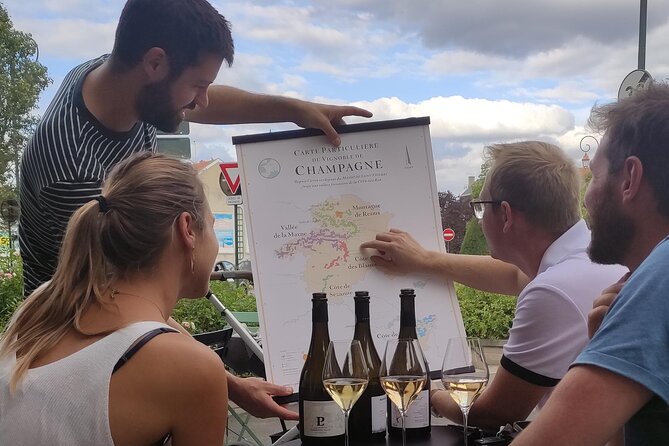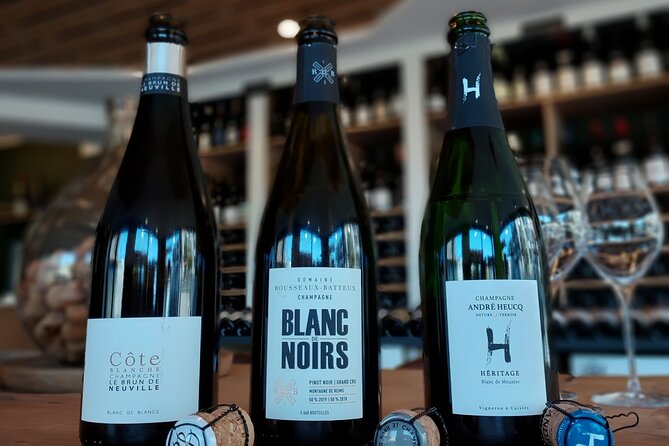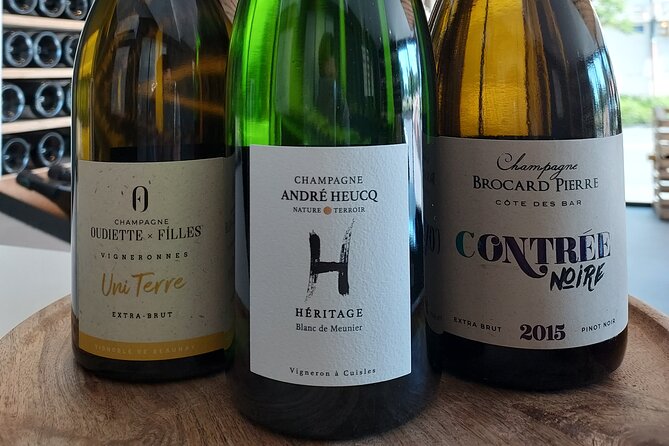Unraveling the complexities of champagne’s distinctive character starts with understanding its core grape varieties. Chardonnay, Pinot Noir, and Pinot Meunier each contribute unique qualities that blend together harmoniously. While Chardonnay offers crisp elegance, Pinot Noir lends depth and structure. Pinot Meunier, on the other hand, imparts a softness that rounds out the overall profile. Exploring these three grapes in isolation unveils their individual nuances, paving the way for a deeper appreciation of champagne’s captivating flavors. With this foundational knowledge, one can embark on a delightful journey to discover the true essence of this renowned sparkling wine.
Key Points

- Understanding the unique flavor profiles of Chardonnay, Pinot Noir, and Pinot Meunier is crucial for appreciating the complexity of champagne.
- Chardonnay’s vibrant acidity, delicate citrus, and subtle minerality contribute elegance and finesse to champagne blends.
- Pinot Noir’s structure, body, and red fruit notes provide depth and complexity to champagne’s flavor profile.
- Pinot Meunier’s softness, roundness, and early maturity impart fruitiness and balance to champagne.
- Exploring the intricate blending process that combines these three grape varieties is key to discovering the nuances of champagne.
Exploring Champagne Grape Varieties
Exploring the champagne grape varieties is key to understanding the unique character of this renowned sparkling wine.
The three main grapes used in champagne production are Chardonnay, Pinot Noir, and Pinot Meunier.
Chardonnay brings elegance and finesse, with flavors of citrus and green apple.
Pinot Noir contributes structure, body, and red fruit notes.
Pinot Meunier offers fruitiness and early maturity.
The blending of these grapes in varying proportions results in the complex and balanced champagne style.
Understanding the role of each grape variety allows wine enthusiasts to better appreciate the nuances and diversity within the champagne category.
Mastering the champagne grape varieties is an essential step in becoming a true connoisseur of this iconic sparkling wine.
You can also read our reviews of more tours and experiences in Epernay.
Tasting the Chardonnay Grape

One of the hallmark grape varieties in champagne is Chardonnay, known for its elegant and refined character.
When tasting Chardonnay in champagne, you can expect to experience:
- Vibrant acidity that provides a crisp, refreshing mouthfeel.
- Delicate flavors of citrus fruits, such as lemon and green apple.
- Subtle notes of minerality that reflect the chalky soils of the Champagne region.
- A creamy texture that can result from barrel aging or extended lees contact.
Chardonnay’s versatility makes it a beloved component in many champagne blends, contributing both structure and finesse to the final product.
Discovering the Pinot Noir Grape

The Pinot Noir grape is a crucial component in many champagne blends, contributing depth, complexity, and a distinctive red fruit character.
Known for its thin skin and delicate nature, Pinot Noir requires meticulous care in the vineyard to produce high-quality grapes.
During the champagne production process, the Pinot Noir grape lends its vibrant acidity and subtle tannins, helping to balance the wine’s structure.
Whether used as a single-varietal champagne or blended with Chardonnay and Pinot Meunier, the Pinot Noir grape is an indispensable part of the champagne experience, lending its unique signature to the final product.
Understanding the Pinot Meunier Grape
Pinot Meunier, a lesser-known but vital grape variety within the champagne region, plays a crucial role in the production of this iconic sparkling wine.
This grape variety:
-
Brings softness and roundness to the blend, complementing the structure and acidity of Chardonnay and Pinot Noir.
-
Thrives in the cooler, northern climate of the Champagne region, allowing for consistent ripening.
-
Contributes to the development of the wine’s complexity and depth of flavor over time.
-
Represents approximately a third of the total grape composition in many classic champagne blends.
Understanding the Pinot Meunier grape is essential for appreciating the nuances and balance that make champagne such a unique and delightful sparkling wine.
Champagne Production Process Walkthrough

Crafting the perfect champagne is a meticulous process, one that begins long before the distinctive bottles reach consumers’ hands.
It starts with the harvesting of the three authorized grape varieties – Chardonnay, Pinot Noir, and Pinot Meunier. The grapes are then pressed, and the resulting juice is fermented into base wines.
Next, the wines are blended, and a second fermentation is initiated, which traps CO2 and creates the champagne’s signature bubbles.
After aging for a minimum of 15 months, the bottles are riddled, disgorged, and dosaged before being corked and labeled.
This intricate sequence of steps yields the complex, elegant champagne that’s enjoyed around the world.
- Discovery Tour (2 Tastings)
- The Connoisseurs From Epernay (Private Half Day Champagne Tour)
- Private Champagne Moët Et Chandon, Pommery, Pressoria
- Champagne: Private Round Transfer From Paris
- From Reims/Epernay:The Connoisseurs Private Tour 9 Tastings
- Aÿ Champagne: 3-Day Canal and Vineyard Tour by House Boat
Champagne Flavor Profiles Examination
With the specialized grape varieties that go into champagne production, one can expect a diverse range of flavor profiles.
The three principal grapes – Chardonnay, Pinot Noir, and Pinot Meunier – each contribute unique characteristics:
-
Chardonnay: Brings delicate, citrus-like flavors with notes of green apple and minerality.
-
Pinot Noir: Imparts richer, more structured flavors ranging from red berries to toasted brioche.
-
Pinot Meunier: Adds soft, fruity notes of stone fruits and subtle spice.
Blending these grapes allows champagne houses to create a harmonious, complex flavor profile that enchants the palate.
Pairing Champagne With Cuisine
When it comes to pairing champagne with cuisine, the effervescence and acidity of this sparkling wine offer a versatile match for a wide array of dishes.
Champagne’s bright, refreshing profile complements rich, creamy foods like seafood chowder or risotto. Its crisp bubbles also cut through the fat of dishes like roasted chicken or seared steak.
For lighter fare, champagne enhances the flavors of fresh salads, sushi, or fruit-based desserts.
The versatility of champagne makes it an excellent choice to pair with diverse menus, from casual to formal dining.
Champagne Appreciation and Education
Appreciating and educating oneself on champagne is a captivating journey.
Champagne appreciation and education offer a multifaceted experience, including:
-
Understanding the unique grape varieties that create the distinctive flavors of champagne.
-
Exploring the intricate process of champagne production, from grape harvesting to bottle fermentation.
-
Discovering the art of pairing champagne with various cuisines to enhance the dining experience.
-
Developing the ability to recognize the subtle nuances and complexities of different champagne styles.
Engaging in this pursuit not only enriches one’s knowledge but also cultivates a deeper appreciation for the art and science behind this iconic sparkling wine.
Frequently Asked Questions
What Is the Appropriate Serving Temperature for Champagne?
The ideal serving temperature for champagne is 40-50°F (4-10°C). This chilled temperature brings out the wine’s delicate flavors and aromas, creating a refreshing and balanced drinking experience. Serving champagne too warm can make it taste flat and less vibrant.
How Should I Store an Opened Bottle of Champagne?
You’ll be absolutely blown away by how easy it is to store an opened bottle of champagne! Simply pop a champagne stopper on it, stick it in the fridge, and voila – that bubbly will stay fresh for up to 3 days.
Can I Use Champagne in Cooking or Baking?
Yes, you can use champagne in cooking and baking. Champagne’s acidity and carbonation can add brightness and complexity to dishes like sauces, marinades, cakes, and more. Just be sure to account for the alcohol content when incorporating it into recipes.
What Is the Difference Between Vintage and Non-Vintage Champagne?
Vintage champagne is made from grapes harvested in a single year, while non-vintage champagne blends wines from multiple years. Vintage champagne tends to be more complex and age-worthy, while non-vintage offers a consistent house style year after year.
How Long Does Champagne Typically Last Once Opened?
Opened champagne typically lasts 3-5 days when stored in the refrigerator with the cork reinserted. However, it’s best consumed within a day or two for optimal freshness and flavor.
Sum Up
Champagne is a complex and nuanced beverage, with each of its three primary grape varieties contributing unique flavors. Interestingly, Pinot Meunier, which makes up around 30-35% of the Champagne blend, is often overlooked yet plays a crucial role in softening the blend and enhancing the overall experience. By understanding the individual characteristics of these grapes, wine enthusiasts can deepen their appreciation for the art of Champagne production and unlock new levels of tasting pleasure.
More Wine Tours in Epernay
- Semi Private Solar Boat Cruise in Champagne
- Champagne: Boutique Houses Tour with Restaurant (Private)
- From Epernay : Bubble Champagne Tour 6 Tastings
- The Essential Tour From Epernay With Champagne Tasting
- Epernay: Private Guided Tour of the Heart of Champagne
- From Epernay: Champagne Day Trip With Tastings
More Food & Drink Experiences in Epernay
- Epernay: Jeep tour of the vineyards with tasting and visits
- The Essential Tour From Epernay With Champagne Tasting
- Epernay: Winery and Cellar Tour With Champagne Tasting
- Visit of the Cellars With Non-Alcoholic Tasting
- Epernay and Vineyards With Champagne Tasting
- Champagne Munoz Bruneau : Half Day Visit and Tasting
More Tour Reviews in Epernay
- Semi Private Solar Boat Cruise in Champagne
- Epernay: Jeep tour of the vineyards with tasting and visits
- Champagne: Boutique Houses Tour with Restaurant (Private)
- From Epernay : Bubble Champagne Tour 6 Tastings
- The Essential Tour From Epernay With Champagne Tasting
- Epernay: Private Guided Tour of the Heart of Champagne
Not for you? Here's more nearby things to do in Epernay we have reviewed
- Semi Private Solar Boat Cruise in Champagne
- Epernay: Jeep tour of the vineyards with tasting and visits
- Champagne: Boutique Houses Tour with Restaurant (Private)
- From Epernay : Bubble Champagne Tour 6 Tastings
- The Essential Tour From Epernay With Champagne Tasting
- Epernay: Private Guided Tour of the Heart of Champagne
- Epernay: Winery and Cellar Tour With Champagne Tasting
- Paris: Champagne & Christmas Markets Tour of Reims & Epernay
- From Paris: One Day to Discover Champagne
- Discovery Tour Reims and Epernay
- The Heart of the Champagne Region
- 3 Hours Semi Private Solar Boat Cruise in Champagne
